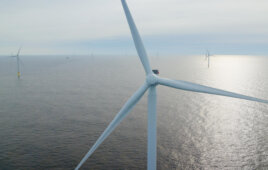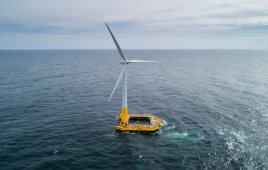Equipment can be anything used by companies to erect or maintain a wind farm. This discussion will deal mostly with cranes because these have been specialized to lift heavy loads to considerable heights, mostly in response to a quest for taller towers. Other equipment, such as the road graders and bull dozers, easily transport to construction sites for general purpose work. But the cranes, because of their heights to 300 ft and enormous lift capacities – some 55 tons – make them specialized to wind turbine erection.
Designs from Europe and the U.S. deserve attention. One recent crane transports its main unit on a standard semi-trailer and requires additional hardware that loads onto only three semi-trailers transport (four trucks total) for the rest of the crane. The vertical tower, a six-section telescopic mast, extends up to 81 m (266 ft). Four spreaders at the top of a mast attach by cables to four stabilizers at the base of the crane. A telescopic luffing boom mounts at the top of the vertical tower. Fully extended, the crane has a hook height of more than 140 m (459 ft). The company says the crane maximizes lifting capacity while offering a lower cost of operation than existing equipment.
In offshore wind work, European engineers are a bit ahead of U.S. engineers because Europe has just about run out of land for on-shore wind plants. Offshore work will involve more than barges, because they would be unstable. One solution so far has been the four-legged jack up barge. A Dutch company mounted the crane portion of a crawler crane (developed for wind farms) on a self-propelled jack-up barge. It is the first ship to have a permanently mounted telescopic crane on board. (Other jack-up barges working in Europe but use other crane designs.)
The design firm says it prefers the telescopic crane because of smaller space requirements in comparison to lattice-boom cranes normally be used, and the crane’s lower center of gravity thanks to a completely retractable boom. The advantages make it possible for a substantial hook height even on a relatively small barge. The crane has received several modifications for its work offshore. Instead of its Diesel engine, for instance, an electric motor will operate the crane, powered by the ship’s power plant. The U.S. has recently begun planning its offshore work. For instance, one U.S. ship builder has announced plans with a Spanish wind turbine manufacturer to build floating construction equipment for erecting at least 5-MW turbine in U.S. waters.
Filed Under: Offshore wind





